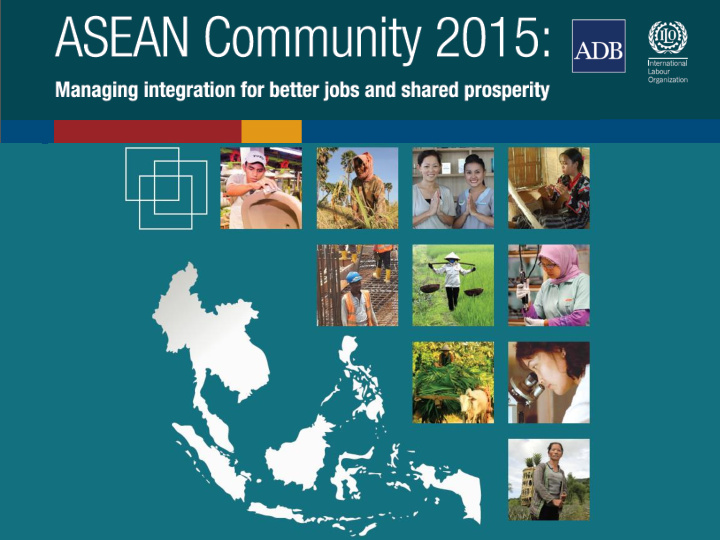



2 Overview Background Findings of the study Current situation AEC impact Priorities for action
3 Background Findings of the study Current situation AEC impact Priorities for action
BACKGROUND Focuses on how AEC 2015 affects people through the 4 labour market How can integration be managed to ensure inclusive growth? What will be the impact on job creation, job quality, women? What kind of skills will be in demand? What will be the effect on productivity and wages? What will be the implication for labour migration? Draws on CGE model simulations, occupational projections, policy analyses, ASEAN employers’ survey, extensive consultations
5 Background Findings of the study Current situation AEC impact Priorities for action
6 IMPRESSIVE ECONOMIC PERFORMANCE, BUT POOR QUALITY JOBS AND GENDER GAPS PERSIST
CURRENT SITUATION ASEAN integration in the global context 7 • US$2.4 trillion GDP in 2013; 300 million labour force • Relative resilience to global economic crisis • Between 2007-13, ASEAN economies grew faster than global average • Changing trade and FDI flows • Rising FDI inflows relative to rest of the world • Rapidly growing middle class • From 1991-2013, 83 million workers joined the middle class; number expected to reach 144 million by 2017 • But rising inequality is a major concern
CURRENT SITUATION ASEAN integration in the global context 8 • Considerable labour market deficits 2 in 5 workers in low-productivity agriculture • 3 in 5 workers in ‘vulnerable’ employment ( own-account plus unpaid • family workers) • High informality, with low social protection coverage • 13% youth unemployment Persisting gender disparities in the labour market •
9 Background Findings of the study Current situation AEC impact Priorities for action
1 0 AEC WILL DELIVER BENEFITS TO THE REGION, BUT RISKS LEAVING SOME BEHIND AND AGGRAVATING INEQUALITIES
AEC IMPACT Managing structural change for decent jobs AEC could increase GDP by 7.1% and add 14m net jobs by 2025 • 1 Gains and losses will be uneven – varying by country, sector, gender • 1 Change in employment under the AEC relative to baseline, 2025 (000s and % of total employment) 7 000 14 6 000 12 5 000 10 4 000 8 3 000 6 2 000 4 1 000 2 0 0 Cambodia Viet Nam Philippines Thailand Lao PDR Indonesia Change in thousand, female (left axis) Change in thousand, male (left axis) Change in per cent of total employment (right axis)
AEC IMPACT Managing structural change for decent jobs Sectors likely to grow include trade, transport and construction • 1 New jobs could be in sectors that are vulnerable and informal • 2 Vulnerable employment as a share of additional job gains under the AEC scenario, 2025 (%) Viet Nam Indonesia Thailand Lao PDR Cambodia Philippines 0 20 40 60 80
AEC IMPACT Moving up the skills ladder Different skills demand: high (+41%), medium (+22%) and low (+24%) • 1 Skills gaps likely to worsen: high-skilled jobs filled by underqualified • 3 Estimated skills and educational mismatch in high-skilled occupations, 2025 (000s and %) 16 000 80 12 000 60 8 000 40 4 000 20 0 0 Lao PDR Cambodia Viet Nam Thailand Philippines Indonesia Additional underqualified workers under AEC in thousand (left axis) Underqualified workers under baseline in thousand (left axis) Total underqualified workers as per cent of high-skill employment (right axis)
AEC IMPACT Linking wages to productivity AEC could create productivity gains – and scope for higher wages • 1 Wages of skilled workers likely to increase most from AEC • 4 Change in labour productivity under the AEC, 2010-25 (%) 140 120 100 80 60 40 20 0 Agriculture Industry Services Total Agriculture Industry Services Total Agriculture Industry Services Total Agriculture Industry Services Total Agriculture Industry Services Total Agriculture Industry Services Total -20 Cambodia Indonesia Lao PDR Philippines Thailand Viet Nam Change under baseline Additional change under AEC
AEC IMPACT Reaping the benefits of labour mobility Intra-ASEAN migration increased from 1.5m to 6.5m (1990-2013) • 1 Mostly medium and low skilled workers • 5 • Concentrated in construction, agriculture and domestic work • AEC provisions on skilled labour mobility likely to have little impact 7 high-skill occupations under AEC, various years (000s and % of total employment) Employment in the seven occupations Share of seven occupations in total (thousand) employment (%) Total Male Female Total Male Female Cambodia (2012) 70.1 45.5 24.7 1.0 1.2 0.7 Lao PDR (2010) 37.8 21.2 16.6 1.3 1.4 1.1 Viet Nam (2012) 735.7 345.2 390.5 1.4 1.3 1.6 Indonesia (2010) 355.3 203.9 151.5 0.3 0.3 0.4 Philippines (2011) 454.5 209.5 245 1.2 0.9 1.7 Thailand (2010) 295 124.6 170.4 0.8 0.6 1.0
1 6 Background Findings of the study Current situation AEC impact Priorities for action
1 7 TO REALIZE THE FULL POTENTIAL OF THE AEC AND DELIVER SHARED PROSPERITY, ASEAN MUST TAKE DECISIVE ACTION… NOW
PRIORITIES Decent work in an integrated ASEAN 1 8 A. FACILITATE AND MANAGE STRUCTURAL CHANGE B. ENSURE THAT ECONOMIC GAINS LEAD TO SHARED PROSPERITY C. STRENGTHEN REGIONAL COOPERATION
Ultimately, the success of ASEAN 1 regional integration will depend 9 on how it affects the labour market – and therefore on how it improves the quality of life of women and men in the region. The full report “ASEAN Community 2015: Managing integration for better jobs and shared prosperity” can be accessed at: www.ilo.org/asia
Recommend
More recommend